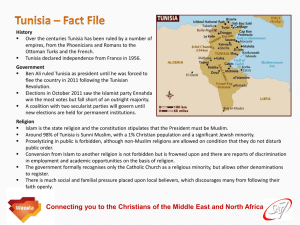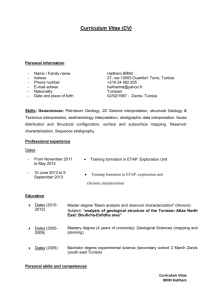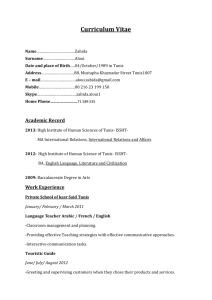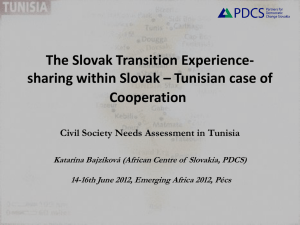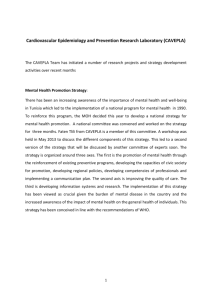Plant Protection News
advertisement
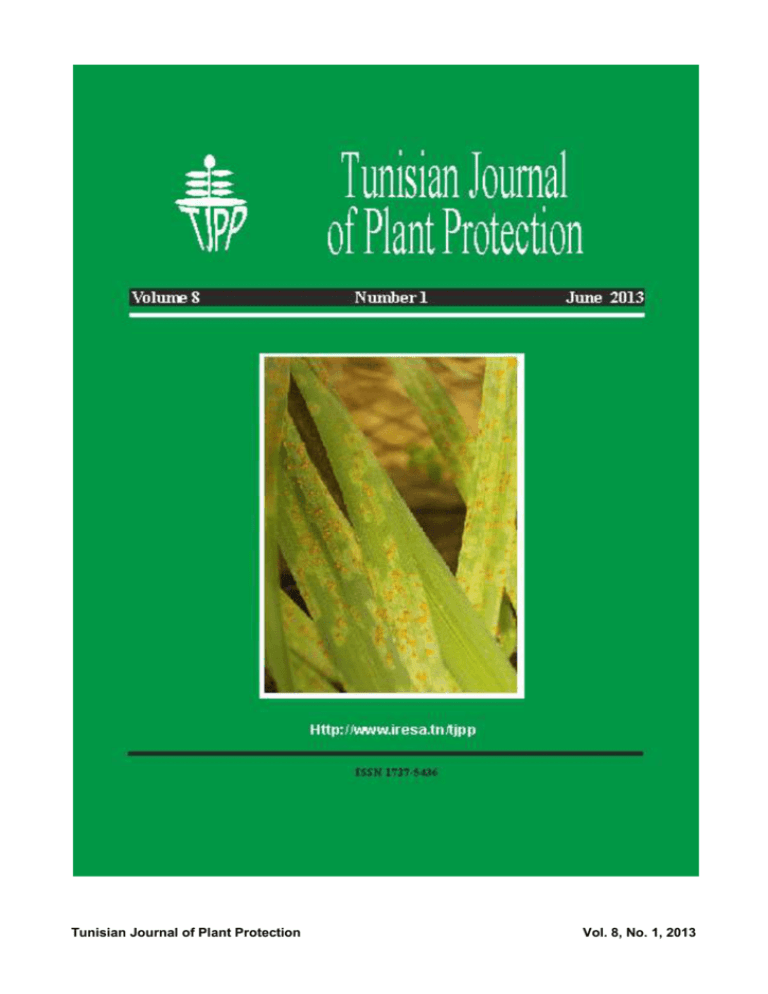
Tunisian Journal of Plant Protection Vol. 8, No. 1, 2013 Tunisian Journal of Plant Protection Volume 8 Number 1 June 2013 Scientific Journal Hosted in theInstitution de la Recherche et de l’Enseignement Supérieur Agricoles(Tunisia) Created and Hosted in the Ecole Supérieure d’ Agriculture du Kef (Tunisia ), from 2006 to 2012 Editor-in-Chief Assistant Editor-in-Chief Daami-Remadi, Mejda Nasraoui, Bouzid Phytopathology, C R R H A B Ch -M Phytopathology,INAT Editorial Board Barbouche, Naïma Entomology, I N A T B en Hamoud a, M. Habib Entomology, I N A T Ben Jamâa, M. Lahbib Entomology, I N R G R E F Chérif, Mohamed Phytopathology, I N A T/ C T A Hajlaoui, M. Rabeh Phytopathology, I NR A T Hamada, Walid Disease Resistance,E S A K Horrigue-Raouani, Najet Nematology, I S A Ch-M Ksantini, Mohieddine Entomology, I O Mekki, Mounir Weed & Pesticide Sc., I S A Ch-M Rhouma, Ali Phytopathology,I O Evaluation Board Tunisian Scientists and : Abou-Haider, Mounir G., Phytopathology, Canada Bayaa, Bassam,Phytopathology, Syria Benazoun, Abdessalam,Entomolgy, Morocco Bernier, Louis, Phytopathology, Canada Besri, Mohamed, Phytopathology, Morocco Bouzned, Zouaoui, Phytopathology, Algeria Dellagi, Alia,Phytopathology, France Du Jardin, Patrick,Biotechnology, Belgium Duncan, Larry, Nematology, Florida USA Fargette, Mireille,Nematology, France Fuchs, Jacques G., Biol. Control, Switzerland Hullé, Maurice, Entomology, France Ippolito, Antonio,Phytopathology, Italy Kamoun, Sophien, Phytopathology, Ohio USA Kema, Gert, Phytopathology, Netherlands Kerlan, Camille,Phytopathology, France Kreiter, Serge, Acarology, France Kremer, Robert J., Weed Sc., Missouri USA Lepoivre, Philippe,Phytopathology, Belgium Lieutier, François,Entomology, France Makkouk, Khaled, Phytopathology, Lebanon Mateille, Thierry,Nematology, France Mugniery, Didier,Nematology, France Peever, Tobin, Phytopathol., Washington St., USA Ramade, François,Eco-Toxicology, France Reignault, Philippe,Phytopathology, France Russo, Agatino,Entomology, Italy Schiffers, Bruno, Pesticide Sc., Belgium Schoelz, James,Phytopathology, Missouri USA Simpson, Stephen J., Entomology, Australia Tirilly, Yves,Phytopathology, France Ziedan, El Sayed, Phytopathology, Egypt Sustaining Members Institution de la Recherche et de l’Enseignement Supérieur Agricoles (IRESA) Ecole Supérieure d’Agriculture du Kef (ESAK) Visa no. 2872/04-04-2005 Tunisian Journal of Plant Protection Vol. 8, No. 1, 2013 Tunisian Journal of Plant Protection http://www.iresa.tn/tjpp email: tjpp@iresa.tn Volume 8, Number 1, June 2013 Contents MYCOLOGY 1. Some recent progress in oat crown rust in Tunisia. M.B. Allagui. (Tunisia) 7. Use of seminotherapy to improve the control of Septoria leaf blotch of durum wheat in Tunisia. K. Taher, M.M. Fakhfakh, A. Bouajila, S. Rezgui, M. Khammassi, J. Haber, B. Nasraoui, and A. Yahyaoui. (Tunisia/Germany) ENTOMOLOGY 23. Hot air treatment for postharvest control of the date moth Ectomyelois ceratoniae. A. Zouba, M. Jmoui, B. Chermiti, A. Msetra, and H. Bouabidi. (Tunisia) 33. Fumigant control of the Mediterranean flour moth Ephestia kuehniella with the noble laurel Laurus nobilis essential oils. J. Mediouni-Ben Jemâa, N. Tersim, E. Boushih, K. Taleb-Toudert, and M.L. Khouja. (Tunisia/Algeria) 45. Parasitoids of the almond bark beetle Scolytus amygdali in Tunisia. A. Zeiri, M. Braham, and M. Braham. (Tunisia) 57. Molecular identification of Eurytoma striolata reared from almond bark beetle Scolytus amygdali in Tunisia. A. Zeiri, M. Braham, and M. Braham. (Tunisia) Photo of the cover page: Oat crow rust disease (Courtesy Mohamed Bechir Allagui) Tunisian Journal of Plant Protection Vol. 8, No. 1, 2013 Guest Editorial Pesticides and Beneficial Insects: Do we Need Better Regulations? The controversy around banning pesticides that has an adverse effect on beneficial insects such as bees or natural enemies of pests that attack economic crops is many decades old, but no serious action on this issue was taken by governments across the globe. Recent news indicated that the European Union is seriously considering to establish a two-year ban on three pesticides suspected of contributing to the global decline in the number of bees. Already 15 countries voted to allow the European Commission (EU) to restrict the use of insecticides from December 2012. However, it seems that the EU failed to reach the majority needed to adopt the ban outright, meaning the decision is passed to the EU. The three insecticides are “imidocloprid”, “clothianidin” and “thiamethoxam”, all of them are used as seed treatment in addition to applying them as soil drench or sprayed on beeattractive plants, such as cereals. It is important to note that bee numbers went down in the Middle East, Europe and USA by up to 85% in some regions. The role of bees in helping plants to bear fruits through enhancement of flower pollination is a common knowledge. However, the influence of the manufacturing companies on the political machine of their respective countries is always a hurdle which is not easy to cross. Accordingly, eight countries, including the United Kingdom voted against the ban. The pesticides companies stress the point that the ban is a poor decision because it is based on an incomplete scientific analysis. This is an open invitation to world scientists, including those in the Middle East and North Africa to investigate this issue further and produce reliable data that can explain what happens in the field. Many small farmers rely on the income generated by bee products, not to mention the indirect other benefits of a balanced bee population, and if the scientific evidence proves harmful effects of some chemicals to bees or other beneficial insects, the ban should also be considered outside Europe. Dr. Khaled Makkouk National Council for Scientific Research Beirut, Lebanon Tunisian Journal of Plant Protection Vol. 8, No. 1, 2013 Plant Protection News Announcement of The 1st Africa-International Allelopathy Congress (AIAC-2014) Sousse, Tunisia, February 6 – 9, 2014 I. Background Allelopathy Looking Ahead The rapidly growing human population has increased the dependence on fossil fuel based agrochemicals (fertilizers or pesticides) to produce the required agricultural and forestry products. This has exerted a great pressure on the non-renewable fossil fuel resources, which cannot last indefinitely. Besides, agrochemicals pollute the environment, the pests develop tolerance to pesticides and their new resistant strains are emerging. Hence, such practices cannot remain in use for ever. One safe alternative to overcome these problems is the use of allelopathy to sustain development in agriculture and forestry and maintenance of a clean environment for our future generations. Allelopathy has great potential to increase the productivity of field crops, vegetables, Tunisian Journal of Plant Protection fruits/forestry trees, fisheries etc., using allelochemicals as pesticides and as growth regulators (using the stimulatory allelopathic effects) in agriculture. Besides, it aims at reducing the environmental pollution and maintaining an ecological balance in fauna and flora through reduced use of nitrogenous fertilizers and pesticides (weedicides, nematicides, insecticides and fungicides) and substituting them with biological nitrogen fixation, natural products (plant and microbial), allelochemicals and phytochemicals free from all problems arising from the use of agrochemicals. Allelopathy is a new and potential area of research. Although farmers have observed problem's related to allelopathy since the beginning of agriculture, planned research was started only from 1940. Presently, much information is available on its basic aspects in the developed countries but Vol. 8, No. 1, 2013 very little research has been done in developing countries of Tropics and SubTropics (suitable climate for round the year cropping), where there is great scope of allelopathy research owing to multiple cropping, agroforestry systems and different agroecosystems. In the near future, allelopathy may be used in (i). crop production, crop protection, agroforestry and agrohorticultural practices, (ii) to increase agricultural production in Sustainable Organic Agriculture and (iii) to reduce environmental pollution. Thus, it is now receiving more attention from Agri- and Bioscientists. Currently, Organic Agriculture is becoming popular due to health concerns and public awareness about the ill effects of Modern Agriculture. Hence, this Congress aims (i) to bring together active allelopathy researchers from worldwide, (ii) to highlight the present status of research in the thrust areas and to plan for the future, (iii) to review progress, (iv) to identify constraints and (v) to project future goals for Basic and Applied Allelopathy Research in Organic Agriculture. Congress themes: In multiple sessions, the following themes will be developed: T1: Allelopathy in sustainable and organic agriculture T2: Allelopathy in natural ecosystems T3: Allelopathy in soil sickness T4: Chemistry of allelochemicals T5: Molecular biology and genetics of allelopathy T6: Physiology and biochemistry of allelopathy T7: Allelopathy mechanisms and interactions T8: Allelopathy methodologies and modeling II. Organizers Tunisian Journal of Plant Protection The 1st Africa-International Allelopathy Congress will be organized jointly by the Higher Agronomic Institute of Chott-Mariem (ISA-ChM) & the Tunisian Association for Sustainable Agriculture in collaboration with: Horticulture and Organic Agriculture Agriculture -ChM -ChM SITE” Coordinator Rabiaa Haouala (ISA-ChM, Tunisia) Organizing Committee Khemeis Abdellaoui (ISA-ChM, Tunisia) Hamadi Boussetta (ISA-ChM, Tunisia) Ikbal Chaieb (CRRHAB, Tunisia) Mejda Daami-Remadi (CRRHAB, Tunisia) Bouthaina Dridi-Al Mouhandes (ISAChM, Tunisia) Sadok Kammoun (ISA-ChM, Tunisia) Raja Kammoun (ISA-ChM, Tunisia) Raoudha Khanfir-Ben Jenana (ISA-ChM, Tunisia) Shi-ming Luo (South China Agricultural University, China) Shamsher S. Narwal (Chief Editor Allelopathy Journal, India) National Scientific Committee Khemeis Abdellaoui (ISA-ChM) Chedly Abdelly (CBBC) Mohamed Ben Khedher (CTAB) Mohamed Bouaziz (ISBS) Abdelhamid Boujelben (ISA-ChM) Olfa Bousaadia (IO) Hamadi Boussetta (ISA-ChM) Ikbal Chaieb (CRRHAB) Brahim Chermiti (ISA-ChM) Vol. 8, No. 1, 2013 Mejda Daami-Remadi (CRRHAB) Bouthaina Dridi-Al Mouhandes (ISAChM) Néziha Ghanem-Boughanmi (FSB) Rabiaa Haouala (ISA-ChM) Hayfa Jabnoun-Khiareddine (CRRHAB) Sadok Kammoun (ISA-ChM) Raja Kammoun (ISA-ChM) Raoudha Khanfir-Ben Jenana (ISA-ChM) Asma Laarif (CRRHAB) Messaoud Mars (ISA-ChM/CRRHAB) Mohamed Naffati (IRA-Mednine) Bouzid Nasraoui (INAT) Najet Raouani-Horrigue (ISA-ChM) International Scientific Committee Ibrahim Alsaadawi (Bagdad University, Iraq) Min An (Charles Sturt University, Australia) Zahid Ata Cheema (University of Agriculture, Faisalabad, Pakistan) Frank Dayan (Thad Cochran Research Center, USA) Marina Della Greca (Università Degli Studi, Napoli, Italy) Shi-ming Luo (South China Agricultural University, China) Shamsher S. Narwal (Chief Editor Allelopathy Journal, India) Manuel Reigosa-Roger (University of Vigo, Spain) Leslie Weston (Presidente of IAS, USA) Ren-sen Zeng (South China Agricultural University, China) III. Symposium languages English and French are the official languages of the Congress. IV. Contacts Dr. Rabiaa Haouala The Higher Agronomic Institute of ChottMariem Phone: 00 (216) 73 327 544/546; GSM : 00 (216) 98 526 832 Fax: 00 (216) 73 327 591 Tunisian Journal of Plant Protection Dr. Mejda Daami-Remadi The Regional Center of Research on Horticulture and Organic Agriculture of Chott-Mariem Phone: 00 (216) 73 327 543; GSM : 00 (216) 94 641 104 Fax: 00 (216) 73 327 070 Email: allelopathytunisia@yahoo.com Facebook Page: African Allelopathy V. Abstracts Abstracts submission Participants are invited to send an abstract in English stating the research theme (T1, T2,… T8). Accepted manuscripts will be published in Allelopathy Journal (www.allelopathyjournal.org) or in Tunisian Journal of Plant Protection (http://www.iresa.tn/tjpp). The abstract should not exceed 300 words. Use 12 pt font size and times new roman fonts. Official paper language: English Deadlines Abstract submission: October, 15th 2013. Acceptance notification: October, 31th 2013. Early registration: September, 15th 2013. Manuscript submission: December, 31th 2013. VI. Registration Fees Local participants: Researchers: 350 TND (Early registration), 400 TND (Late registration). Students: 300 TND (Early registration), 350 TND (Late registration). Foreign participants: Researchers: 350 USD (Early registration), 400 USD (Late registration). Students: 300 USD (Early registration), 350 USD (Late registration). Vol. 8, No. 1, 2013 Registration includes: Accommodation (4 nights), breakfast, lunches, dinners, refreshment breaks, registration kit. Post Congress Tour to Famous Tourist Sites in Monastir, Mahdia and El Jem, for one day (optional with limited places). $50 USD (70 TND) (Travel + Food + Site seeing Tickets, etc.). INTERNATIONAL SHORT COURSE ON ALLELOPATHY (ISCA): Registration Fees (Foreigners): Scientists: 300 USD, Students: 250 USD Registration Fees (Tunisian): Scientists: 300 TND, Students: 250 TND Registration Deadline: December 31th, 2013. ------------- Tunisian Journal of Plant Protection Vol. 8, No. 1, 2013 Report on International Symposium on Crop Protection Management in Mediterranean Organic Agriculture Sousse, Tunisia, May 14 - 16, 2013 Organic Agriculture has experienced a rapid expansion in recent years, with continued growth globally and in the Mediterranean region, where it offers sustainable development opportunities and initiatives. Crop protection is of major concern for the successful management of organic farms and is considered as one of the most challenging tasks that organic farmers are facing. Both yield and quality can be severely affected by pests and diseases, even if available preventive measures have been accurately applied. The development of ecologically sound control methods against pest and diseases is therefore a necessary part of organic research agendas. Some 100 researchers from 14 countries (Albania, Algeria, Belgium, Egypt, Germany, Iraq, Italy, Jordan, Morocco, Poland, Saudi Arabia, Syria, and Tunisia) participated in the Symposium ‘Crop protection management in Mediterranean Organic Agriculture’, which was jointly organized by the Technical Center of Organic Agriculture, Tunisia (CTAB), the International Society of Organic Agriculture Research (ISOFAR) and the Tunisian Journal of Plant Protection Mediterranean Organic Agricultural Network (MOAN). The organizers succeeded in compiling an attractive scientific program, which included about 30 oral presentations and over 40 posters all targeted on finding sustainable solutions for crop protection problems in organic plant production. The event started with a remarkable speech given by the Chief of Cabinet of the Minister of Agriculture of Tunisia. In his speech, the Chief of the Cabinet confirmed that organic agriculture fits well in the national strategy, which is based on selfsufficiency in basic foodstuff, export promotion, protection of the environment and improvement of farmer’s income. In this context, organic agriculture plays an important role by offering products of high quality while simultaneously preserving the ecological balance. Furthermore, the Chief of Cabinet mentioned that the Tunisian Government actively supports the development of organic agriculture, by the implementation of a national committee, a general direction and regional directions for organic agriculture, a technical center of organic agriculture, etc.... Training of Vol. 8, No. 1, 2013 farmers and innovative research is considered as a key element that contributes to the successful development of the organic sector. The plenary sessions continued with presentations on the current situation of organic agriculture in Tunisia, an overview of the research activities of the Mediterranean Agricultural Institute of Bari (IAMB) and an outline on current research on microbial control of insects in Tunisia. Further, sessions included insect and disease management with a strong focus on microbial control and botanicals. Fortunately the list of speakers included many young researchers, which were given the opportunity to present their results on a conference. Fortunately, a considerable proportion of the young speakers presented high quality work. Two of them were rewarded at the end of the conference for the best oral presentation and the best poster presented. Another positive aspect related to the contents was the considerable amount of contributions on basic research on pests and diseases. This type of research, e.g. on the auxiliary fauna is generally work intensive and not easy to publish. On the other hand, this type of study is an important part of any research agenda in organic agriculture, which is mainly focusing on understanding the systems and on the principle of prevention. Some of the approaches presented however may cause problems with the self conception of organic agriculture or even with the general legislation. The use of mycotoxin producing fungi such as Aspergillus flavus, for example, is an ambivalent approach for organic systems. Summaries of all contributions have been compiled in an abstract book that is available via the website of ISOFAR. The last day of the Symposium was dedicated to an excursion which was focusing on citriculture and horticulture completed by interesting cultural visits. This symposium offered a great opportunity for all participants to share information and experiences about crop protection and Organic Agriculture under Mediterranean conditions. The atmosphere during the symposium was more than convenient. Foreign participants had the great chance to enjoy the hospitality of the Tunisian hosts. The Organizing and Scientific Committees deserve full gratitude. Dr. Mohamed Ben Khédher For the Organizing and Scientific Committees ------------------- Tunisian Journal of Plant Protection Vol. 8, No. 1, 2013 Recent Doctorate Theses in Plant Protection (2012/13) Mansour, Ramzi. 2012. Toward enhancing Integrated Pest Management programs of mealybugs (Hemiptera: Pseudococcidae) in Tunisian and Sicilian vineyards. Doctorate Thesis in Plant Protection, joint supervision INAT, University of Carthage, Tunisia and Universita degli Studi di Catania, Italy, 156 pp. (Public Defense: 22 September 2012) Two mealybug species, Planococcus ficus and Planococcus citri, and an armored scale species, Hemiberlesia lataniae, were recorded throughout Tunisian table-grape vineyards. P. ficus was by far the most widespread scale insect species within the investigated grape growing areas and was also recorded on fig trees. Most (74%) of the investigated Tunisian vineyards were infested by mealybugs. About 70% of the mealybug-infested vineyards were categorized as slightly to moderately infested by these insects. All collected Anagyrus pseudococci s.l. specimens were identified as A. sp. near pseudococci. Additionally, one primary parasitoid Coccophagus sp. and one hyperparasitoid Chartocerus sp. were also reared from mealybugs. Six ant species were found in Tunisian mealybuginfested table-grape vineyards. They are Tetramorium semilaeve, Plagiolepis schmitzii, Tapinoma nigerrimum, Crematogaster schmidti, Pheidole pallidula and Pheidole teneriffana. The four latter species were reported tending mealybugs on grapevines. T. nigerrimum was found to be the most common ant species on grapevine and the most associated with the mealybugs. The morphological examination of some vine mealybug (P. ficus) Tunisian Journal of Plant Protection populations collected from Tunisian vineyards showed the existence of two different P. ficus populations in Tunisia. Likewise, in the molecular (Ribosomal ITS1) analysis, two separate clades were revealed in the Neighbour-joining phylogenetic tree, supporting the morphological studies suggesting that there are two distinct populations of P. ficus on grapevine in Tunisia. This is the first study showing the occurrence of two morphologically and genetically different populations of P. ficus on grapevine in Tunisia. The number of captured A. sp. near pseudococci females in vine mealybug sex pheromone (LS) baited traps was significantly higher than that in unbaited traps. The minimal number of days for the first parasitoid emergence in LS baited traps was 16 days, namely almost 3 days earlier, compared to unbaited control. These findings resulted in a significant increase in the parasitism of the mealybugs P. citri by A. sp. near pseudococci in LS baited traps relative to unbaited traps. Insecticide treatments (buprofezin or chlorpyriphos-methyl) significantly affected parasitization activity of A. sp. near pseudococci on mealybugs when compared to the untreated control. Vol. 8, No. 1, 2013 Regarding contact toxicity, the insecticide chlorpyriphos-methyl caused 100% parasitoid mortality 24 h after treatment, but parasitoid mortality from the insecticides Prev-Am® or spirotetramat was almost absent. Neither the total parasitoid offspring/female nor the sex ratio of the progeny was negatively affected by Prev-Am® or spirotetramat relative to the untreated control. According to the IOBC classification for laboratory trials, both Prev-Am® and spirotetramat were rated harmless (IOBC category 1), whereas chlorpyriphos-methyl was categorized as harmful (IOBC category 4) to A. sp. near pseudococci. None of the insecticides adversely affected the development of the parasitoid pupal stage inside vine mealybug mummies or the survival of the emerged parasitoids. In laboratory conditions, parasitism of P. ficus and P. citri by their respective encyrtid parasitoids A. sp. near pseudococci and Leptomastix dactylopii was negatively affected by the ant T. nigerrimum. Similarly, T. nigerrimum was shown to significantly disrupt the predatory activity of Cryptolaemus montrouzieri larvae when foraging on host citrus mealybugs. By contrast, the presence of T. nigerrimum did not negatively influence the predatory potential of C. montrouzieri adults when feeding on citrus mealybugs. Consequently, the encyrtid parasitoids A. sp. near pseudococci and L. dactylopii and the larval stage of the predator C. montrouzieri may be considered as T. nigerrimum-sensitive, whereas adults of C. montrouzieri may be regarded as T. nigerrimum-resistant predators. ----------------- Sahraoui, Hajer. 2012. Influence of agro-ecological practices and plant protection on phytoseiid mites communities in Tunisian citrus orchards. Doctorate Thesis in Plant Protection, joint supervision INAT, University of Carthage, Tunisia and Montpellier SupAgro, France, 196 pp. (Public Defense: 11 December 2012) Mites of the family Phytoseiidae (Mesostigmata) have been extensively studied because of the potential of several species as biological control agents of phytophagous mites and small insect crop pests. Phytoseiidae diversity and abundance are known to be mainly affected by climate, stability of habitats, food resources and agricultural practices. This study conducted in Tunisian citrus orchards aimed to (i) characterize the diversity of Phytoseiidae in these agrosystems, (ii) study the effect of agricultural practices on the diversity and abundance of these species and (ii) study Tunisian Journal of Plant Protection the effect of weed management strategies on these predatory mites. The results obtained allow giving some responses. First, more data are now available on species of Phytoseiidae present on citrus trees and associated weeds. Eleven new species for the Tunisian fauna have been found species of Phytoseiidae, were different according to the species of citrus considered and their abundance seemed to be affected by herbicide sprayings. On weeds, Phytoseiidae diversity was directly affected by weed diversity. Furthermore, their density was influenced by pesticide sprayings and the weed Vol. 8, No. 1, 2013 management type. A positive correlation between Phytoseiidae densities on trees and weeds was emphasized. Ambulatory dispersal between weeds and trees was observed and migrations were higher from weeds to trees than in the opposite way. This dispersal seemed to be favored by some weeding practices, especially by ploughing. At last, the comparison of plots conducted with different farming strategies showed that Phytoseiidae diversity was the highest in the organic farming plot. The results presently obtained allow a better understanding of relationships between Phytoseiidae and Tunisian Journal of Plant Protection their habitat. They also allow some proposals to improve agricultural practices and promote a better biological control of mite pests (eliminate herbicide use, promote ploughing and mowing). However, additional studies are still required in order to test more weeding strategies, propose new ones and to better characterize the interactions between Phytoseiidae and agrosystems management. --------------- Vol. 8, No. 1, 2013 Instructions to Authors The Tunisian Journal of Plant Protection is published in English twice a year. Contributionson all aspects of plant protection are considered. Papers are evaluated by highly qualifiednationaland internationalscientistsof the related disciplines. The originalmanuscriptshouldbe s ubmittedto theEditor-in-Chief: Prof. Bouzid Nasraoui InstitutNationalAgronomiquede Tunisie, 43 AvenueCharles Nicolle,1082 Tunis-Mahrajène,Tunisia Email: tjpp@iresa.tn Phone: (+216)98 29 29 17 Submitted manuscript must not be publishedor submitted for publicationelsewhere. Manuscriptsshouldbe emailed on Microsoft Word and Microsoft Excel. It shouldbe typed on one side page (A4 format) in doublespace (Times New Roman, 12), starting by the titlein the center, followed by author names and their addresses. Three abstracts are required : English,Arabic and French. Thetwo lattercome at theend of themanuscript.When necessary, theJournalmay translate theEnglishabstract intoArabicand/orFrench. Abstracts start with the title of the manuscriptand finish by the keywords with seven words at most. The other sections of the manuscript are : Introduction,Materials and Methods, Results,Discussion,Acknowledgement(if necessary), French and Arabic abstracts,and Literature Cited.Not dividedshortcommunicationsand review articles are also published. Tables should be cited in numeric order in the manuscript. They must be intelligible withoutreference to the text. The title should summarize the information presented in the table. Subheadingsshould be brief. Abbreviationsare accepted but thosewhich are not standard must be explainedin footnotes. Figures shouldalso be presentedin numeric order.Captionsshoulddescribethecontents, so each illustration is understandablewhen considered apart from the text. Color photos are publishedonlyon-line;they are black and whiteon thepaper version. References in thetext shouldbe cited by theirnumbers.In the LiteratureCited, references must be reported in their originallanguagewhen latin alphabet is used, otherwise,they have to be translated to English between square brackets and their original language mentioned between brackets.They shouldbe numbered and arranged in alphabeticalorder,with authorlast names, their initials,publicationyear, title,journal or other source, volumeand page numbers.Examples below must be followed. Articlein a journal: Haddar,T. 1989.Check list of weeds naturallyinfestingagriculturalfields in northernTunisia.Arab Journal ofPlant Protection7: 174-178. Chapterin a book: Nasraoui, B. and Lepoivre, P. 2003. Les champignons phytopathogènes.Pages 111-143. In: Phytopathologie,bases moléculaires et biologiquesdes pathosystèmeset fondements des stratégiesde lutte.P. Lepoivre,Ed.EditionsDe Boeck Université.Belgium. Proceedings: Medini, M., Hamza, S., Harrabi, M., and Lamari, L. 2003. Virulence of Mycosphaerella th graminicolafrom Tunisia, Algeria and Canada. Pages 14-44. In: Proceedings of the 6 InternationalSymposiumon Septoriaand StagonosporaDiseases of Cereals. December 812, 2003,Tunis,Tunisia. Book: Jarraya, A. 2003. Principauxnuisiblesdes plantes cultivées et des denrées stockées en Afrique du Nord: leur biologie,leurs ennemis naturels,leurs dégâts et leur contrôle.Maghreb Editions, Tunisia,415 pp. Thesis : Horrigue-Raouani,N. 2003.Variabilitéde la relation hôtes-parasitesdans le cas des Meloidogyne spp. (Tylenchida,Meloidogynidae).Doctorat Es-Sciences Naturelles.Faculté des Sciences de Tunis,UniversitéAl-Manar,Tunisia,222 pp. Tunisian Journal of Plant Protection Vol. 8, No. 1, 2013 Tunisian Journal of Plant Protection Vol. 8, No. 1, 2013
